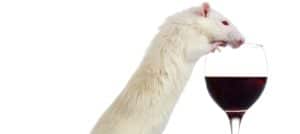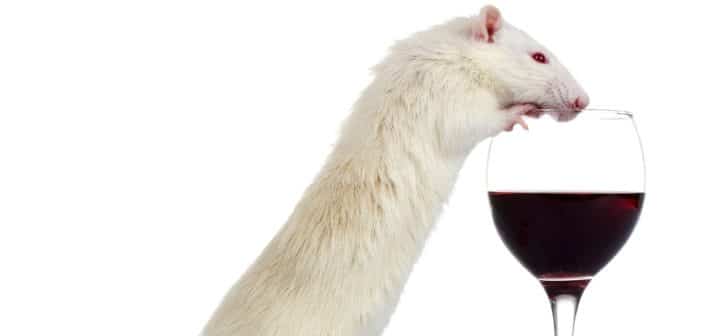 I know people who simply can’t stop drinking, no matter how hard they try. The urge is just too great. Hell, for a while, I was one of those people. I just couldn’t resist the call of the bottle. Despite the consequences, alcoholics keep their foot on the drinking accelerator and crash through every responsibility imaginable. And—for non-alcoholics—it doesn’t make any sense. Until now.
I know people who simply can’t stop drinking, no matter how hard they try. The urge is just too great. Hell, for a while, I was one of those people. I just couldn’t resist the call of the bottle. Despite the consequences, alcoholics keep their foot on the drinking accelerator and crash through every responsibility imaginable. And—for non-alcoholics—it doesn’t make any sense. Until now.
Researchers may have zeroed in on an enzyme that triggers the irresistible urge to keep drinking alcohol. According to a new study, researchers have successfully linked the drinking urge to an enzyme in the brain that protects and preserves impulse control. It’s an important discovery that reveals as much about the human brain as it does about the future of addiction treatment.
Resistance is Futile
The urge to drink, the study found, is triggered by an enzyme called “PRDM2.” Researchers found that “alcohol use and dependency may reduce the levels of this enzyme” which, in turn, reduces impulse control. When less PRDM2 was produced in the brains of lab rats, the rats drank more alcohol. In fact, the study’s authors discovered that the rats “consumed more alcohol, even when the experience was unpleasant for them.” (Which pretty much sums up the last few joyless years of my own drinking career when I was gagging down glasses of wine, alone, and trying not to throw up.)
What’s notable is that while scientists already knew the brain was responsible for alcohol dependency, this particular study reveals “the first evidence of a specific chemical process that could be linked to overconsumption of alcohol, and to alcohol use when an individual is stressed.” Researchers also found that the more the rats drank, the less PRDM2 they produced. Put another way, the higher the rodents climbed, the less of a safety net there was. “When the enzyme was less abundant in the animals’ brains, the rodents were also more likely to search for and help themselves to alcohol in response to stress,” the study said.
Control Groups
The test itself was a “series of experiments involving rats that had been exposed to breathing alcohol vapor for 14 hours a day over seven weeks,” a ReliaWire report on the study said. The exposure to alcohol vapor made the rats “dependent” on alcohol. Afterward, researchers conducted a series of experiments, “including seeing whether they continued to drink alcohol when it was mixed with bitter-tasting quinine.” The answer was a resounding “yes.” Researchers also compared and contrasted the behavior of rats who had been genetically modified to not produce the enzyme. Weeks after being cut off from alcohol vapor, alcohol-dependent rats had lower levels of PRDM2 in their brains. Similarly, “when scientists restricted the production of PRDM2 in rats that were not already dependent on alcohol, it resulted in similar types of behavior, reflecting a decrease in impulse control.”
Rats that weren’t alcohol-dependent had similar impulse control when researchers adjusted their PRDM2 levels, too. “To make sure PRDM2 was at work rather than some other factor, researchers decreased production of the enzyme in rats who weren’t addicted to alcohol. Sure enough, impulse control was disrupted in these rats as well, indicating that PRDM2 plays a role in the cycle of alcohol dependence,” a story at Bustle noted. “Alcohol abuse itself appears to reduce production of the enzyme, and that reduction leads to problems with impulse control.” Interestingly, rats that had been genetically engineered to not produce PRDM2 behaved the same way: “Compared to rats with normal PRDM2 production, they were likely to drink more alcohol, to drink compulsively despite the bitter quinine taste, and to drink alcohol in response to electric shock stress.”
Alcoholic Rat Race
Markus Heilig, a psychiatry professor and head of a neuroscience center at Linköping University, has dedicated his career to understanding why some people have trouble with the bottle while others don’t. “The enzyme, PRDM2, has previously been studied in cancer research, but we didn’t know that it has a function in the brain,” he said. With what he and his team have discovered about PRDM2, they’re now exploring its implications on alcoholism and addiction research. Heiling notes that PRDM2 “controls the expression of several genes that are necessary for effective signalling between nerve cells,” as the Bustle article said. “In rats that don’t produce enough of the enzyme, cells that should control the urge to drink may not be able to send effective signals, leading to problems with impulse control even when researchers made alcohol consumption unpleasant. Furthermore, rats were likely to relapse into drinking when they were subjected to stress. If that sounds familiar, it’s because humans do the same thing.”
The article admits that while animal models (like rats) aren’t perfect analogs to humans, they’re still plenty worthwhile. According to the LiveScience piece, the PRDM2 is game-changing when it comes to proving that alcohol dependence is biological—not a failure of willpower or strength of character. Additionally, their findings may contribute to finding a way to help alcoholics kick their addiction. “Now that we’re beginning to understand what’s happening, we hope we’ll also be able to intervene,” said Dr. Heilig.
“Prior studies have suggested that in the early stages of human evolution, a taste for alcohol may have been beneficial, as it could have allowed humans’ ancestors to extract nutrition from rotting or fermented fruit,” the LiveScience piece went on. “However, the idea that moderate drinking carries health benefits for people today may be a popular misconception.” The story cites a “a recent review of 87 studies show[ing]that the people who live the longest are those who limit drinking to a minimum.” If nothing else, it shows that the urge to drink isn’t just a social factor or cue—it’s something that resonates from deep within people. And now that the actual “urge” can be identified, it can be controlled—and, more importantly, treated.
Sponsored DISCLAIMER: This is a paid advertisement for California Behavioral Health, LLC, a CA licensed substance abuse treatment provider and not a service provided by The Fix. Calls to this number are answered by CBH, free and without obligation to the consumer. No one who answers the call receives a fee based upon the consumer’s choice to enter treatment. For additional info on other treatment providers and options visit www.samhsa.gov.




